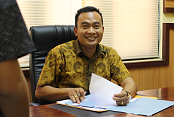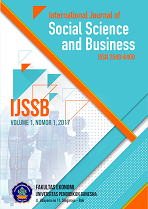Addressing the Urban Heat Island Effect in Yogyakarta: The Role of Human Behaviour and Community Engagement in Mitigating Heat Impacts
DOI:
https://doi.org/10.23887/ijssb.v8i4.84827Kata Kunci:
Urban Heat Effect, Human Behaviour, Community Engagement, Heat Impacts, YogyakartaAbstrak
Environmental researchers have extensively examined the effects of urban heat islands. However, there seems to be a dearth of research on how communities perceive and engage with these effects. Urban heat effects have been a major environmental concern in Yogyakarta for the last 11 years. Urban heat islands have been widely studied, but research on community perceptions of these effects is limited. Therefore, this study investigates the impact of awareness and knowledge, personal experience, and perceptions on communities' involvement in addressing urban heat island effects, given the significant impact of humans and their potential role as generators of these issues. This study used partial least squares structural equation modeling using SmartPLS version 4.1.0.3 to look at the proposed measurement and structural models based on 481 onsite-collected responses. Findings showed that, although knowledge and awareness do alter how communities feel about being involved in the environmental care activities, they do not have much of an impact on how active the communities actually are. On the other hand, personal experience and perceptions have a significant impact on the effectiveness of community involvement, although they do not alter perceptions of participation. This study highlights the importance of developing targeted strategies that consider both the perceptions and practicalities of community engagement. In managing urban heat islands, it is essential to combine behavioral insights with effective solutions, such as reflective roofing and urban green initiatives. Future research should include longitudinal studies and explore additional factors such as social support and motivational drivers.
Referensi
Aghamohammadi, N., Ramakreshnan, L., Fong, C. S., Noor, R. M., Hanif, N. R., & Sulaiman, N. M. (2022). Perceived impacts of urban heat island phenomenon in a tropical metropolitan city: Perspectives from stakeholder dialogue sessions. Science of The Total Environment, 806, 150331. https://doi.org/10.1016/j.scitotenv.2021.150331
Aldiansyah, S., Wardani, F. (2023). Analisis Spasio-Temporal Fenomena Urban Heat Island dan Hubungannya Terhadap Aspek Fisik di Kota Makassar (1993-2021). Jurnal Sains & Teknologi Modifikasi Cuaca, 24(1), 1-11.
Ali, F., Rasoolimanesh, S. M., Sarstedt, M., Ringle, C. M., & Ryu, K. (2018). An assessment of the use of partial least squares structural equation modeling (PLS-SEM) in hospitality research. International Journal of Contemporary Hospitality Management, 30(1), 514–538.
Alexandro, R. & Oktaria, M. (2020). Corporate Social Responsibility of PT. Kalimantan Sawit Kusuma to Improves Local People Welfare. International Journal of Social Science and Business, 4(3), 407-413, https://doi.org/10.23887/ijssb.v4i3.24714
Antonioni, A., Cabrales, A., Lipari, F., & Sánchez, A. (2022). Comportamiento, decisiones y transición ecológica: aproximaciones experimentales con implicaciones para las políticas. Cuadernos Económicos De ICE, (104). https://doi.org/10.32796/cice.2022.104.7505
Arifwidodo, S., Chandrasiri, O., Abdulharis, R., & Kubota, T. (2019). Exploring the Effects of Urban Heat Island: A Case Study of Two Cities in Thailand and Indonesia. APN Science Bulletin, 9(1). https://doi.org/10.30852/sb.2019.539
Assenova, I. A., Vitanova, L. L., & Petrova-Antonova, D. (2024). Urban heat islands from multiple perspectives: Trends across disciplines and Interrelationships. Urban Climate, 56, 102075. https://doi.org/10.1016/j.uclim.2024.102075
Berame, J. S., Lumaban, N. W., Delima, S. B., Mercado, R. L., Bulay, M. L., Morano, A. B., & Mar G. Parohinog, C. D. (2022). Attitude and behavior of senior high school students toward environmental Cconservation. Biodiversitas Journal of Biological Diversity, 23(10). https://doi.org/10.13057/biodiv/d231036
Bian, Q. (2020). Waste heat: The dominating root cause of current global warming. Environmental Systems Research, 9(1). https://doi.org/10.1186/s40068-020-00169-2
Darhamsyah, D. (2019). Environmental governance urban: Public participation and sustainable development. International Journal of Environment, Engineering and Education, 1(1), 17–24. https://doi.org/10.55151/ijeedu.v1i1.9
Fong, C. S., Aghamohammadi, N., Ramakreshnan, L., Sulaiman, N. M., & Mohammadi, P. (2019). Holistic recommendations for future outdoor thermal comfort assessment in tropical Southeast Asia: A critical appraisal. Sustainable Cities and Society, 46, 101428. https://doi.org/10.1016/j.scs.2019.101428
Fawzi, N.I. & Mufarikah, N.N. (2013). Kajian Urban Heat Island di Kota Yogyakarta – Hubungan Antara Tutupan Lahan dan Suhu Permukaan. Prosiding Simposium Nasional Sains Geoinformasi, 275-280.
Filho, W. L., Wolf, F., Castro-Díaz, R., Li, C., Ojeh, V. N., Gutiérrez, N., Nagy, G. J., Savić, S., Natenzon, C. E., Quasem Al-Amin, A., Maruna, M., & Bönecke, J. (2021). Addressing the urban heat islands effect: A cross-country assessment of the role of Green Infrastructure. Sustainability, 13(2), 753. https://doi.org/10.3390/su13020753
Gannon, M., Rasoolimanesh, S. M., & Taheri, B. (2020). Assessing the mediating role of residents’ perceptions toward tourism development. Journal of Travel Research, 60(1), 149–171. https://doi.org/10.1177/0047287519890926
Fishbein, M., & Ajzen, I. (1975). Belief, attitude, intention and behaviour: An introduction to theory and research. Reading, MA: Addison-Wesley.
Fishbein, M. & Ajzen, 1. (1980). Understanding attitude and predicting social behaviour. Englewood Cliffs, NJ: Prentice Hall.
Garuma, G. F. (2023). Tropical Surface Urban Heat Islands in East Africa. Scientific Reports, 13(1). https://doi.org/10.1038/s41598-023-31678-6
Haider, Z., Hargreaves, C., & Williams, P. (2022). The impact of community-led urban greening projects on urban heat islands. Urban Climate, 45, 101282
Hair, J. F., Hult, G. T. M., Ringle, C. M., & Sarstedt, M. (2022). A primer on partial least squares structural equation modeling (PLS-SEM) (3rd ed.). Thousand Oaks, CA: Sage.
Kiptiah, M., Wahyu, Adawiah, R., & Elmy, M. (2022). Coastal communities’ environmental concerns based on civic culture. International Journal of Science and Society, 4(2), 428–439. https://doi.org/10.54783/ijsoc.v4i2.465
Kock, N. (2017). Common method bias: A full Collinearity Assessment Method for PLS-SEM. Partial Least Squares Path Modeling, 245–257. https://doi.org/10.1007/978-3-319-64069-3_11
Kostka, G., & Zhang, L. (2014). Community-based urban environmental governance and the effectiveness of green infrastructure projects. Environmental Management, 54(4), 767-778.
Muzaky, H. & Jaelani, L.M. (2019). Analisis Pengaruh Tutupan Lahan terhadap Distribusi Suhu Permukaan: Kajian Urban Heat Island di Jakarta, Bandung dan Surabaya. Jurnal Penginderaan Jauh Indonesia, 1(2), 45-51.
Naikoo, M. W., Islam, A. R. M. T., Mallick, J., & Rahman, A. (2022). Land use/land cover change and its impact on surface urban heat island and urban thermal comfort in a metropolitan city. Urban Climate, 41, 101052.
Prasetyo, B.D. & Nurtyawan, R. (2023). Analisis Urban Heat Island di Kota Semarang Berdasarkan Hubungan Kerapatan Vegetasi dan Keterbanginan Kota Terhadap Suhu Permukaan. FTSP Series: Seminar Nasional dan Diseminasi Tugas Akhir 2023.
Rasoolimanesh, S. M., Roldán, J. L., Jaafar, M., & Ramayah, T. (2016). Factors influencing residents’ perceptions toward tourism development: Differences across rural and Urban World Heritage sites. Journal of Travel Research, 56(6), 760–775. https://doi.org/10.1177/0047287516662354
Rasoolimanesh, S. M., Seyfi, S., Hall, C. M., & Hatamifar, P. (2021). Understanding memorable tourism experiences and behavioural intentions of Heritage Tourists. Journal of Destination Marketing & Management, 21, 100621. https://doi.org/10.1016/j.jdmm.2021.100621
Sari, M.F., Prabowo, A.J.T., Kristiawan, D.D., Ramadhan, D.R.S., Fadillah, R., Husna, V.N. (2024). Dinamika Urban Heat Island. Prosiding Seminar Nasional FISIP UNNES.
Šegota, T., Mihalič, T., & Perdue, R. R. (2022). Resident perceptions and responses to tourism: Individual vs community level impacts. Journal of Sustainable Tourism, 32(2), 340–363. https://doi.org/10.1080/09669582.2022.2149759
Sekarsih, F.N., Khasanah, U., Gangga, P. S., & Saputra, R. A. (2024). Kajian pengaruh perubahan penutup lahan terhadap kenaikan suhu permukaan di Kota Yogyakarta. Jurnal Media Informatika, 5(2), 76-82.
Singh, A., & Supina, S. (2023). Community's Attitude Towards the Development of Cultural and Heritage Tourism: An Exploratory Study. In Exploring Culture and Heritage Through Experience Tourism (pp. 76-83). IGI Global.
Supina, S., & Iskandar, H. (2023). Bibiliometric mapping of local communities’ Environmental Conservation Behaviour. E-Journal of Tourism, 241. https://doi.org/10.24922/eot.v10i2.100600
Tong, S., Bambrick, H., Beggs, P. J., Chen, L., Hu, Y., Ma, W., Steffen, W., & Tan, J. (2022). Current and future threats to human health in the anthropocene. Environment International, 158, 106892. https://doi.org/10.1016/j.envint.2021.106892.
Usakli, A. & Rasoolimanesh, S. M. (2023). Which SEM to use and what to report? A comparison of CB-SEM and PLS-SEM. In Okumus, F., Rasoolimanesh, S. M., & Jahani, S. (Eds.), Cutting Edge Research Methods in Hospitality and Tourism. Emerald Publishing. https://doi.org/10.1108/978-1-80455-063-220231002.
Voraseyanont, P., Supina, S., Annishia, F. B., & Lorenza, F. A. (2024). Compare Means Analysis of Domestic Tourists Habits: Daily Actions and Vacationing Actions in Rural Destinations. KnE Engineering, 561-575.
Wang, K., Aktas, Y. D., Stocker, J., Carruthers, D., Hunt, J., & Malki-Epshtein, L. (2019). Urban heat island modelling of a tropical city: Case of Kuala Lumpur. Geoscience Letters, 6(1). https://doi.org/10.1186/s40562-019-0134-2
Wang, C., Wang, Z.-H., Kaloush, K. E., & Shacat, J. (2021). Perceptions of urban heat island mitigation and implementation strategies: Survey and Gap Analysis. Sustainable Cities and Society, 66, 102687. https://doi.org/10.1016/j.scs.2020.102687.
Wang, F., Xiang, L., Sze-Yin Leung, K., Elsner, M., Zhang, Y., Guo, Y., Pan, B., Sun, H., An, T., Ying, G., Brooks, B. W., Hou, D., Helbling, D. E., Sun, J., Qiu, H., Vogel, T. M., Zhang, W., Gao, Y., Simpson,
M. J., Tiedje, J. M. (2024). Emerging contaminants: A one health perspective. The Innovation, 5(4), 100612. https://doi.org/10.1016/j.xinn.2024.100612
Yasir. (2022). Environmental communication through corporate social responsibility in overcoming Peatland Fire problems. International Journal of Social Science and Business, 7(1), 177–187. https://doi.org/10.23887/ijssb.v7i1.50878
Unduhan
Diterbitkan
Cara Mengutip
Terbitan
Bagian
Lisensi
Hak Cipta (c) 2024 Amin Kiswantoro, Tonny Hendratono, Supina Supina, Dwiyono Rudi Susanto, Sugiarto Sugiarto

Artikel ini berlisensiCreative Commons Attribution-ShareAlike 4.0 International License.










